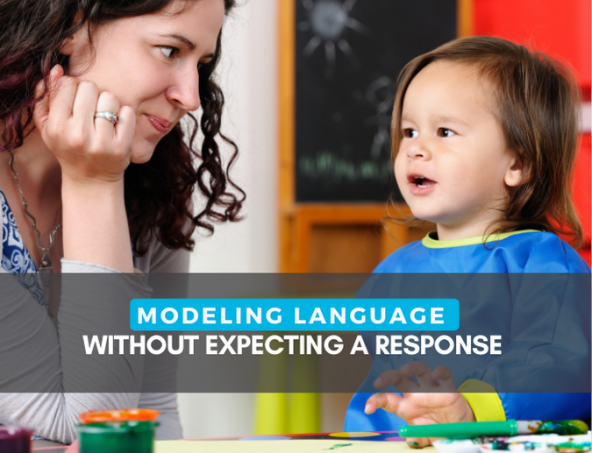Modeling Language Without Expecting a Response

When teaching children with autism to communicate, there are many approaches that Speech Therapists and other professionals use to help children understand and use language. One approach involves modeling language so that the child is hearing what you say and associating it with the situation they are experiencing. In order for this approach to be a positive experience for the child, it is sometimes important and valuable to model the language without necessarily expecting a response. Read this blog for a more complete explanation of this approach.
What does “Modeling Language Without Expecting a Response” mean?
- What does it look like?
It can look like narrating what the child is doing, narrating what you are doing, saying what you are thinking out loud, or speaking as if you are the child. In other words, think about what you think this child wants to be able to say. Then you say it out loud in an applicable context so that if you’re right, they may hear it and then learn to start saying it too! These same principles apply to Augmentative & Alternative Communication (AAC) and sign language.
- What are different forms of modeling language?
You can define aided language stimulation for AAC. Since there is so much language in songs, another wonderful way to model language is through singing. If there is a particular tune that your child likes, then you can sing to that tune while narrating what the child is doing or what you are doing together. If the child is an analytic language learner, there is a technique called the “one up rule.” If the child’s language is at the one-word level, you can model phrases that are 2 or more words. If the child is at the phrase level in language development, you can model sentences that are 3 or more words in length.
- How does modeling language differ from expecting a response?
Expecting a response often sounds like, “Tell me _____”, or “Say ______”, or “Let me hear you say it”, or “You try”, etc. Modeling language sounds like, “I want a cookie!”, “No, mom”, “Mine”, or “Help me!” When we are modeling, we try to avoid saying, “Say, ____” because the child then becomes accustomed to that prompt. We want them to say words spontaneously and when it is meaningful to them! So, by simply demonstrating how to do that, in a meaningful way, they can learn what types of things can be said in different contexts.
The Benefits of Modeling Language
- Building foundational language skills
- Creating a language-rich environment
- Reducing communication anxiety
- Improving receptive language abilities
- Fostering a supportive learning environment
The biggest benefit of modeling is that you increase the number of opportunities that a child gets to see/hear/experience words and their real-life associations/meanings. More opportunities typically equals faster and more well-rounded learning.
Practical Techniques for Modeling Language Without Expecting a Response
- Use of AAC (Augmentative & Alternative Communication) devices
- Employing visual supports and cues
- Implementing the "wait time" approach.
- Creating structured routines and visual schedules
- Strategies for peer modeling and group interactions
- Use the 50/50 rule: 50% of the language you model is at the child’s current level (whether that’s single words/signs/icons), and then 50% of the language you model is at the next level up (so that might be 2-word phrases/sign/icon combinations)
AZA offers comprehensive Speech Therapy Services that incorporate these techniques. If you're seeking support and guidance in implementing these strategies or exploring augmentative and alternative communication methods, Contact our Family Support Team. Our Family Support Team is always available to help and is available at no charge to all members of the autism and developmental disability community. Schedule a free phone appointment that works with your schedule by visiting http://azaunited.org/supportcall
You may also be interested in:
For more helpful resources and information, follow AZA United on social media:






